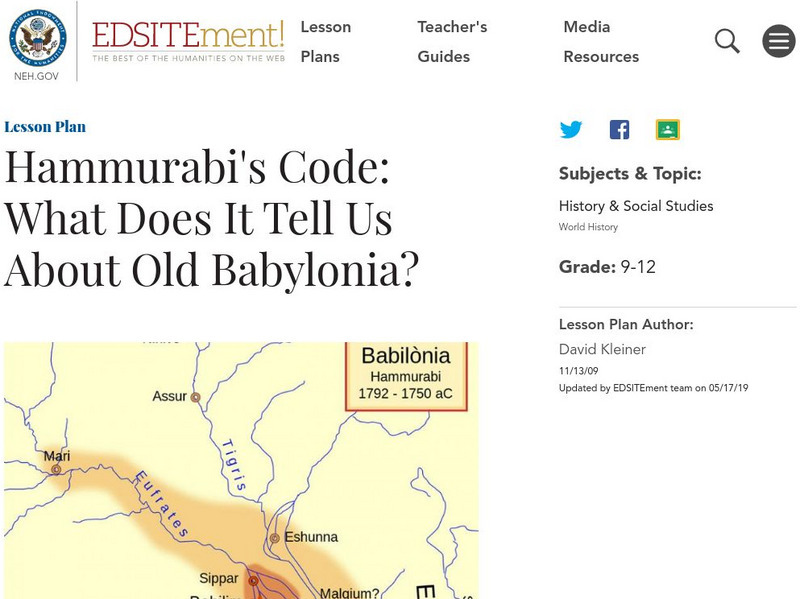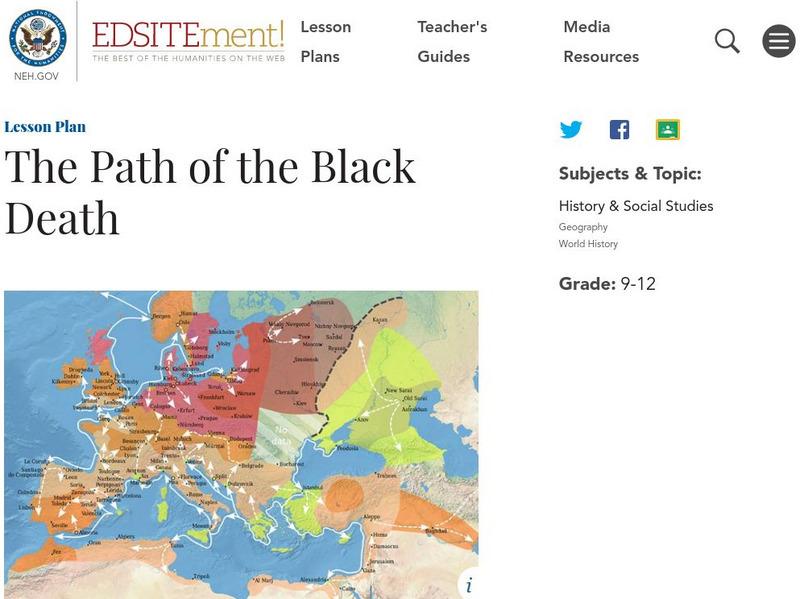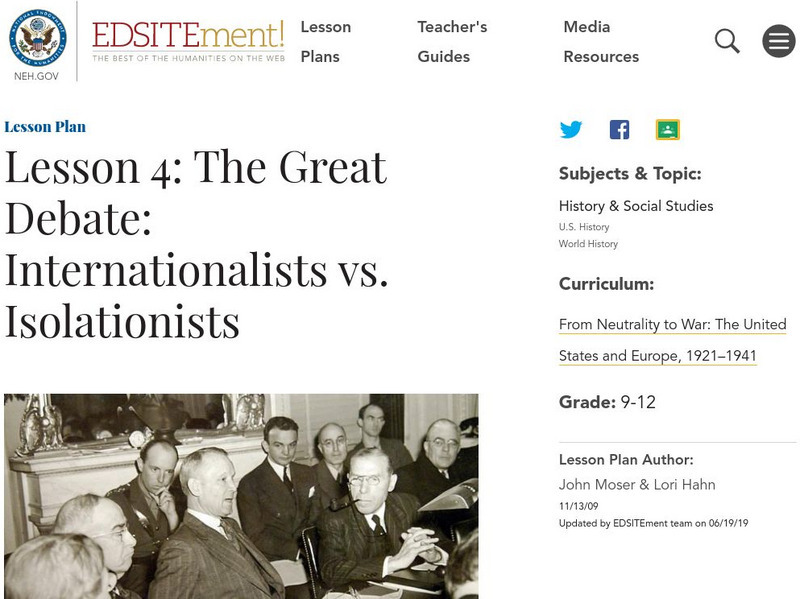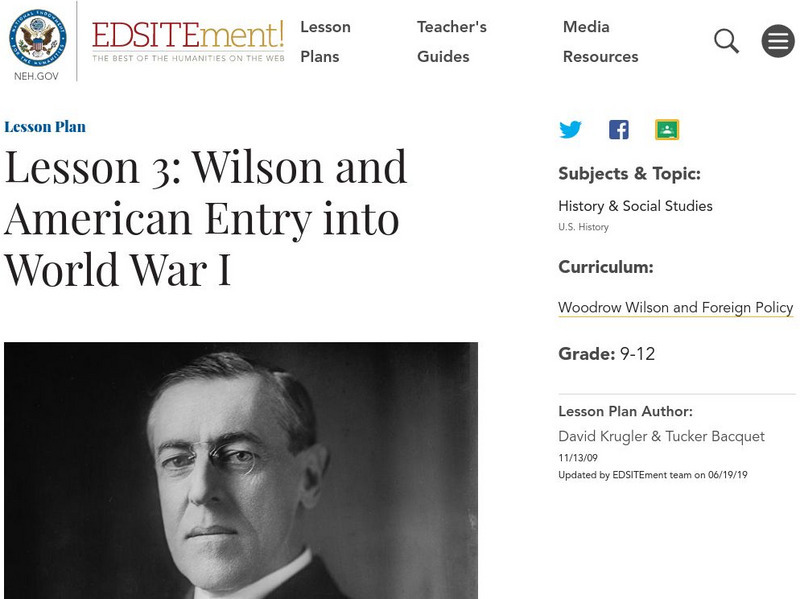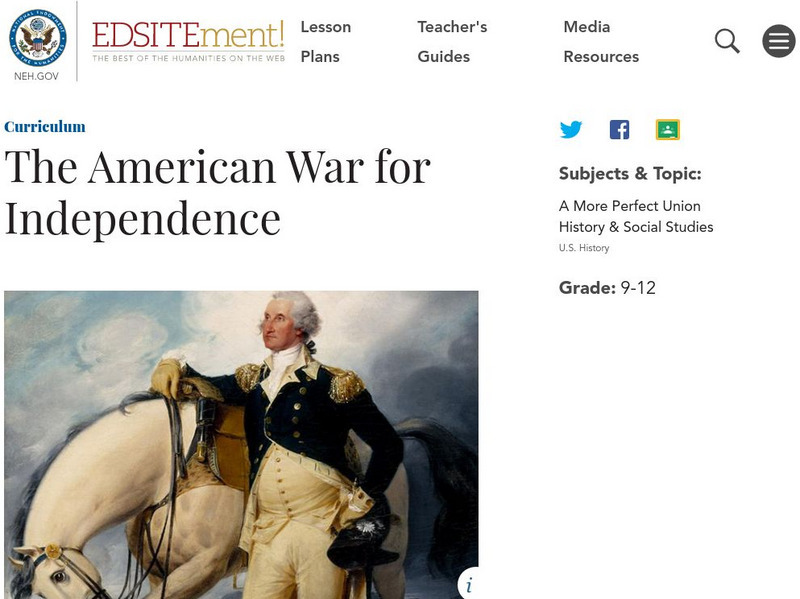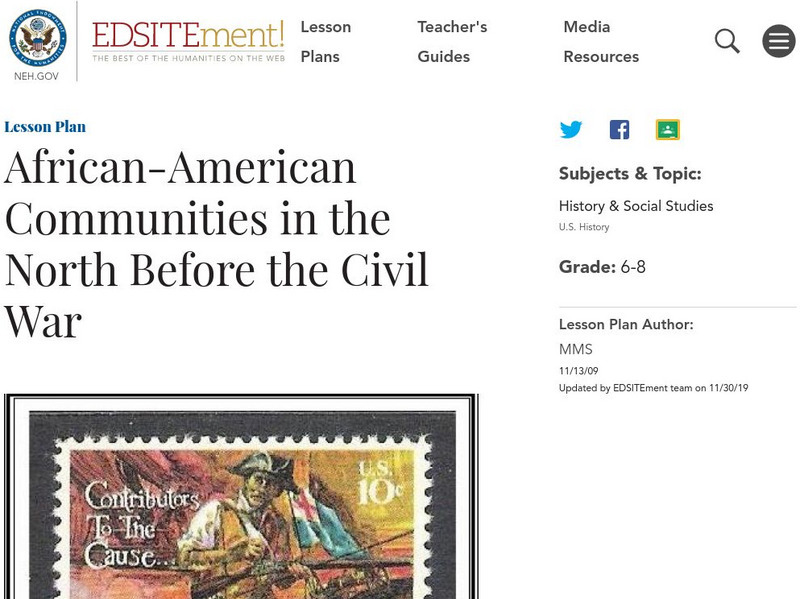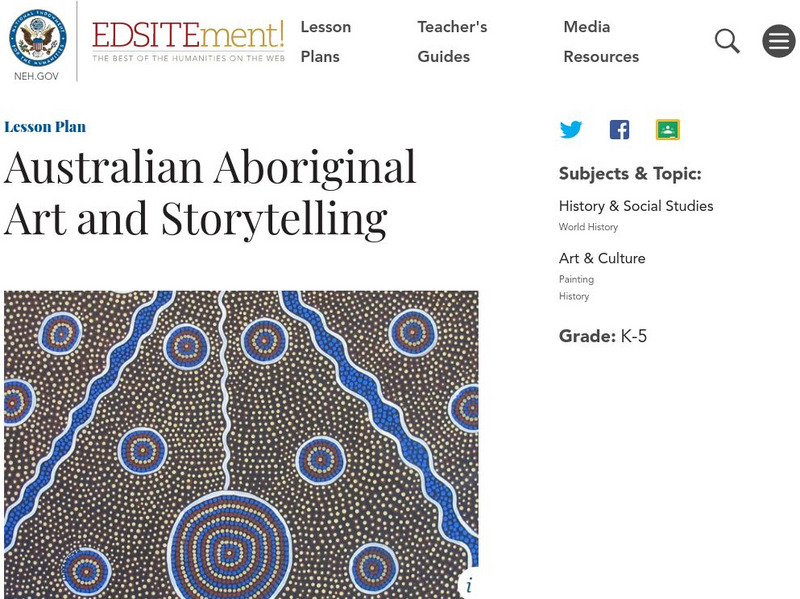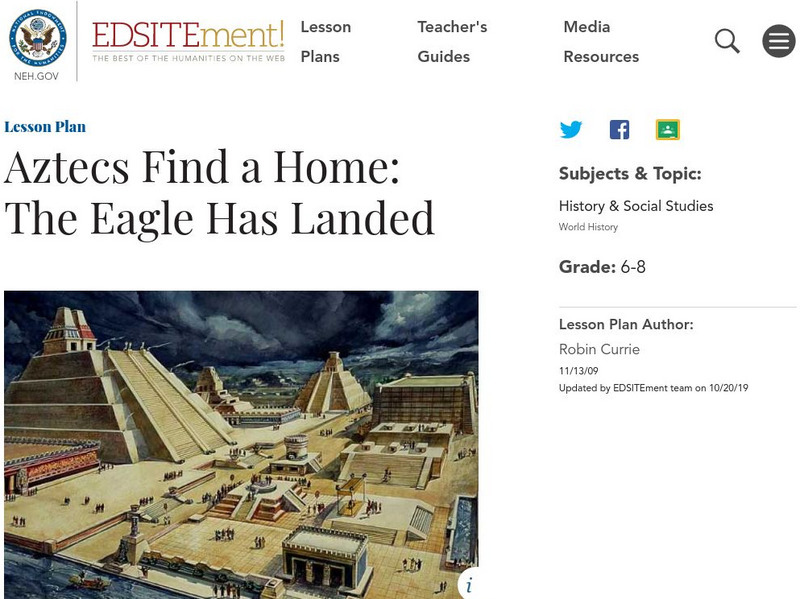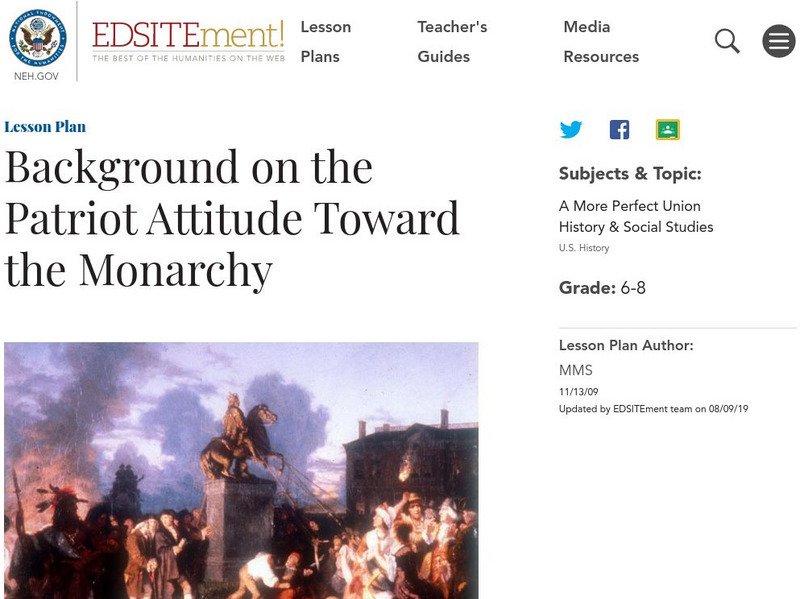National Endowment for the Humanities
The 1828 Campaign of Andrew Jackson and the Growth of Party Politics
High schoolers analyze changes in voter participation and regional power, and review archival campaign documents reflecting the dawn of politics as we know it during the critical years from 1824 to 1832. Students utilize worksheets and...
National Endowment for the Humanities
Understanding the Context of Modernist Poetry
Students examine the historical, social, and cultural context of modernist poetry. They explore websites, complete a chart, compare/contrast rural and urban life, watch a video of early New York, and complete a writing assessment...
National Endowment for the Humanities
From Courage to Freedom: The Reality behind the Song
Students study how Frederick Douglass uses language to describe a realistic picture of slavery in his writings which are primary source documents. They examine his use of word choice, imagery, irony, and rhetorical appeals and use slave...
National Endowment for the Humanities
The 1828 Campaign of Andrew Jackson: Territorial Expansion and the Shift of Power
Young scholars make connections between changes in voting participation and the election of 1828, and describe regional factors evidenced by the voting results of the election of 1828.
National Endowment for the Humanities
Lesson 4: The Phoenicians, the Greeks, the Romans, and Us
Learners review knowledge gained in the three-part unit on the history of the alphabet. Using maps and images, learners consolidate their understanding of ancient Greece, the Romans and the Phoenicians, and their respective impacts...
National Endowment for the Humanities
Shakespeare's Macbeth: Fear and the Motives of Evil
Students use an online search engine (or a printed concordance) to locate passages that highlight Macbeth's response to fear and his descent into evil. They analyze the motives of Macbeth's increasingly desperate and evil actions.
National Endowment for the Humanities
Anne Frank: Writer
Students explore the writings of Anne Frank. They discuss how Anne did or did not change during her two years in the Secret Annex. Students take a stand on how much Anne has in common with contemporary young people.
National Endowment for the Humanities
Folklore in Zora Neale Hurston's Their Eyes Were Watching God
Learners define folklore, folk groups, tradition, and oral narrative. They identify traditional elements in Their Eyes Were Watching God Analyze and understand the role of traditional folkways and folk speech in the overall literary...
National Endowment for the Humanities
Neh: Edsit Ement: The Campaign of 1840
A three-lesson unit on the campaign and election of 1840. Links to many sites for more information, interactive worksheets, lesson objectives, and assessment. From EDSITEment.
National Endowment for the Humanities
Neh: Edsit Ement: Letters From Emily Dickinson
Excellent lesson plan in which young scholars study and analyze the letters that Emily Dickinson wrote to Thomas Higginson and to her sister-in-law, Susan Huntington Gilbert Dickinson, as a method of understanding her poetry in a deeper...
National Endowment for the Humanities
Neh: Edsit Ement: Hammurabi?s Code: What Does It Tell Us About Old Babylonia?
A complete lesson unit on Hammurabi?s Code, for Grades 9-12.
National Endowment for the Humanities
Neh: Edsit Ement: The Path of the Black Death
The Black Death caused a radical alteration in population and dramatic changes in society. In this instructional activity, students will analyze maps, documents, and firsthand accounts to trace the effects of the Black Death in Europe.
National Endowment for the Humanities
Neh: Edsit Ement: The Great Debate: Internationalists vs. Isolationists
This great lesson plan from EDSITEment uses primary sources, an interactive timeline, and guiding questions to examine the debate in the United States over the merits of isolationism vs. internationalism after the passage of the...
National Endowment for the Humanities
Neh: Edsit Ement: Woodrow Wilson and Foreign Policy
A thorough review of Woodrow Wilson's foreign policies in these four lessons offered by EDSITEment. Learn the origins of "Wilsonianism," Wilson's views on relations with countries in Latin America, Wilson's decision to enter World War I,...
National Endowment for the Humanities
Neh: Edsit Ement: Woodrow Wilson and American Entry Into Ww I
This lesson plan explores the ways President Woodrow Wilson tried to keep America out of war as World War I raged in Europe. Examine documents, speeches, and other primary sources to follow America's path from neutrality to war.
National Endowment for the Humanities
Neh: Edsit Ement: Kate Chopin's "The Awakening": No Choice but Under? Unit Plan
This unit plan can be used as a whole, or any of its three parts. Plenty of resources for the context of the novel, and the literary concepts of realism and regionalism are provided.
National Endowment for the Humanities
Neh: Edsit Ement: Profiles in Courage to Kill a Mockingbird
This site offers two separate lesson plans which focus on the theme of "Courage," as portrayed in Harper Lee's "To Kill a Mockingbird," and court transcripts (and other primary source material) from the second Scottsboro Boys Trial of 1933.
National Endowment for the Humanities
Neh: Edsit Ement: Introducing Jane Eyre: An Unlikely Victorian Heroine
Contemporary criticism of the novel, the conditions of Victorian women, and Bronte's decision to publish the novel under a male pseudonym form the focus of this lesson.
National Endowment for the Humanities
Neh: Edsit Ement: The American War for Independence
The decision of Britain's North American countries to rebel against their Mother Country was a risky one. The teaching unit is comprised of three lesson plans. Students explore the diplomatic and military aspects of the American War for...
National Endowment for the Humanities
Neh: Edsit Ement: A Story of Epic Proportions: What Makes a Poem an Epic?
In this lesson plan, learners will consider "A Story of Epic Proportions: What makes a Poem an Epic?." The plan includes worksheets and other student materials that can be found under the resource tab.
National Endowment for the Humanities
Neh: Edsit Ement: African American Communities in the North Before the Civil War
In this lesson plan, students will consider "African-American Communities in the North Before the Civil War." The plan includes worksheets and other student materials that can be found under the resource tab.
National Endowment for the Humanities
Neh: Edsit Ement: Australian Aboriginal Art and Storytelling
In this lesson plan, students will consider "Australian Aboriginal Art and Storytelling." The plan includes worksheets and other student materials that can be found under the resource tab.
National Endowment for the Humanities
Neh: Edsit Ement: Aztecs Find a Home: The Eagle Has Landed
In this lesson plan, students will consider "Aztecs Find a Home: The Eagle Has Landed." The plan includes worksheets and other student materials that can be found under the resource tab.
National Endowment for the Humanities
Neh: Edsit Ement: Background on the Patriot Attitude Toward the Monarchy
In this lesson plan, students will consider "Background on the Patriot Attitude Toward the Monarchy." The plan includes worksheets and other student materials that can be found under the resource tab.












